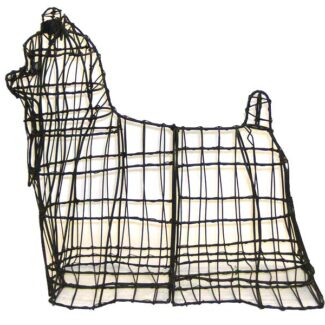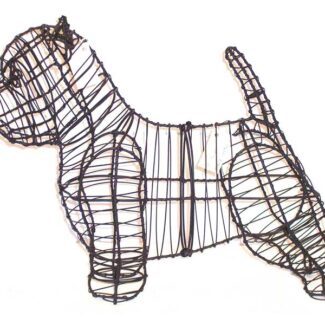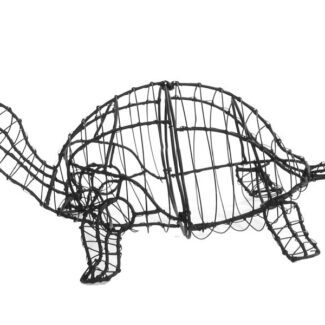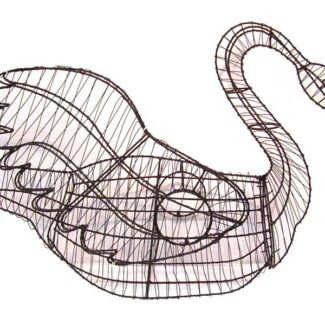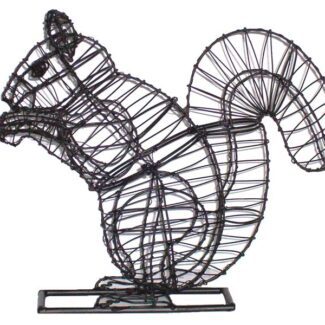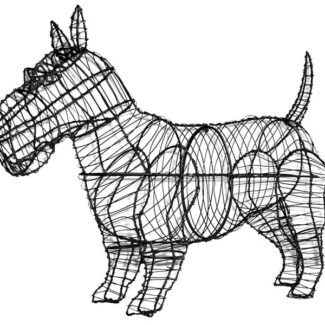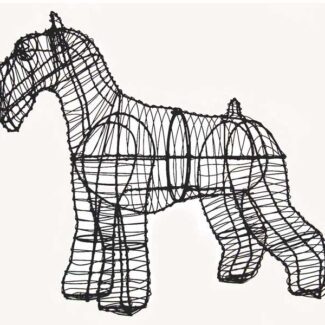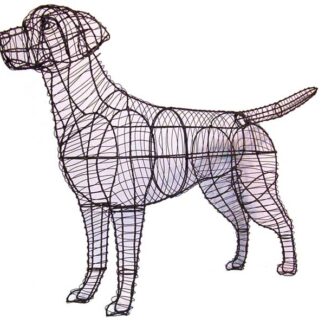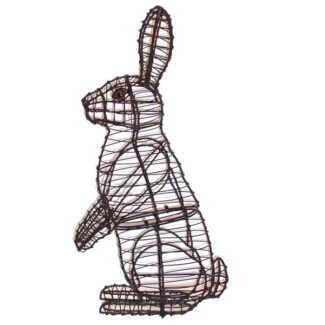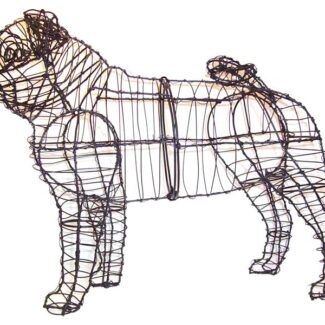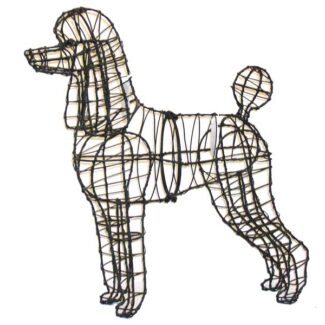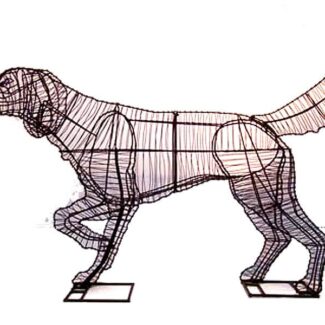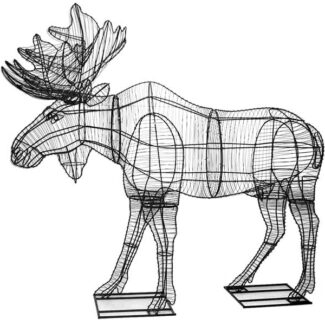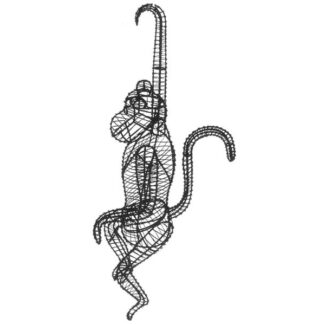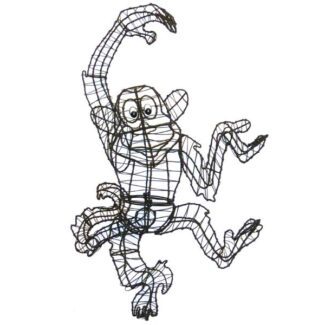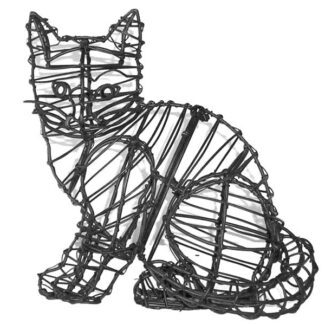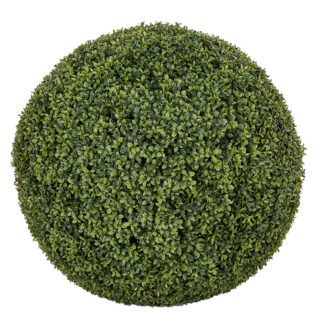Expressive Greenery with Animal-Shaped Wire Topiary Frames
Animal topiaries bring a creative, eye-catching element to any garden or indoor space! And here at TopiaryTree.net, we carry a wide range of wire topiary frames shaped like animals — from classic four-legged figures to elegant bird outlines.
Each frame is built specifically to help you grow plants into expressive sculptural displays. Our wire topiary frames give you the foundation you need to shape greenery into something truly remarkable!
Durability and Design in Every Wire Frame Topiary
Our wire frame topiary selection is made from durable metal, built to last outdoors in all kinds of weather. The frames are formed by hand or machine using round steel bars and tubular reinforcements, and then welded for strength. Each wire frame topiary receives a rust-resistant acrylic coating. Powder coating is also available for added protection.
Custom Sizes for Wire Topiary Frames to Fit Every Space
At TopiaryTree.net, we offer a variety of sizes for wire topiary frames to suit your space. You will surely find a frame to fit your needs, whether you’re decorating a patio or enhancing an outdoor area with a small topiary frame. These structures also pair beautifully with artificial boxwood plants for a maintenance-free yet vibrant finish.
Frequently Asked Questions
Advantages of Wire Topiary Frames for Animal Sculptures
- Structural Precision: Wire frames allow for detailed, recognizable animal shapes — from rabbits to giraffes.
- Creative Flexibility: They can be filled with moss, trained with vines, or used as sculptural bases for artificial greenery.
- Lightweight & Portable: Easier to move and install than stone or wood sculptures.
- Reusable: Frames can be reshaped or replanted for seasonal or thematic changes.
- Whimsical Appeal: Wire topiary frames Adds charm and personality to gardens, events, or commercial spaces.
Construction for Durability & Shape Retention
- Materials: Frames are typically made from steel rods, not just thin wire — offering superior strength. Wire topiary frames are best constructed with steel rod metal with the appropriate rod gauges and metal finish.
- Rod Gauges:
- Small frames: 1/8″–3/16″
- Large frames: 1/4″–3/8″ with internal tubing for support
- Finishes:
- Galvanized steel (best rust protection)
- Powder coating (color options + durability)
- Enamel paint, Galvanized dip or powder coating the metal for added weather resistance
These construction methods ensure the frame holds its shape even under heavy plant loads or outdoor exposure.
Can Wire Topiary Frames Support Moss or Plant Coverings?
Yes — wire topiary frames are designed to support an array of foliages. Best design is to wrap the metal frame with a chicken wire.
- Sphagnum moss, coco liners, or potting soil
- Dense plantings like ivy, creeping fig, sedum, or succulents
- Heavy coverage is supported by internal tubing and reinforced joints
Frames are often stuffed tightly with moss and wrapped with fishing line or florist wire to secure the medium.
Indoor vs. Outdoor Suitability: Wire frame topiary?
Wire topiary frames are suitable for both:
- Outdoor use: Powder-coated and galvanized frames resist rust and weather damage
- Indoor use: Ideal for decorative pieces with artificial or live plants; less exposure to moisture means longer lifespan
For outdoor use, choose frames with UV-resistant coatings and ensure proper drainage and plant selection.
Customization Options for Animal Shapes
- Highly customizable: You can request specific animals, poses, or sizes
- Designs range from tabletop cats to life-sized elephants and even dinosaurs
- Custom fabrication allows for branded, themed, or event-specific sculptures
Artists can incorporate textures (fur, feathers) using plant selection and wire detailing.
Maintenance & Rust Protection
- Minimal maintenance if powder-coated or galvanized
- Recommended care for Wire frame topiary
- Galvanized dip
- Power-coating
- Dust or rinse periodically
- Touch up paint if scratched
- Store indoors during harsh winters
- Rust prevention: Oil sealants, powder coating, or galvanized finishes are key
Materials Used vs. Standard Wire
|
Feature |
Wire Topiary Frames |
Standard Wire (e.g., chicken wire) |
|
Material |
Steel rods (1/8″–3/8″) |
Thin gauge wire mesh |
|
Strength |
High — supports heavy plants |
Moderate — best for small projects |
|
Finish |
Galvanized, powder-coated |
Often uncoated |
|
Shape retention |
Excellent |
Prone to bending |
Steel rods offer superior durability and sculptural integrity compared to basic wire mesh.
Integrating Living Vines or Plants
Two main methods:
- Training Existing Plants:
- Place frame over boxwood, ivy, or euonymus
- Trim regularly to match the shape
- Planting in Moss-Filled Frames:
- Soak moss, insert plants through holes or open frame
- Use creeping vines like fig or ivy
- Water and fertilize like a hanging basket
Design tips:
- Use small-leaved plants for detail
- Mimic animal textures with grasses, succulents, or variegated foliage
Custom Sizing for Displays
Yes — wire topiary frames can be:
- Scaled to fit tabletops, gardens, or large installations
- Tailored to environments like hotel lobbies, zoo exhibits, or event stages
- Built to spec with internal support for moss or live plants
Lead times vary, but custom builds are widely available.
Design Considerations for Your Project
- Scale: Match plant leaf size to frame size for realism
- Texture: Choose plants that mimic fur, feathers, or skin
- Color: Use variegated or flowering plants for visual interest
- Environment: Consider sun exposure, humidity, and temperature
- Maintenance: Opt for drought-tolerant plants if upkeep is a concern
- Theme: Align animal choice with event or brand identity
What are popular animal shapes for topiary designs?
🐶 Domestic Favorites
- Dogs: Especially breeds like poodles, dachshunds, and terriers — often used in hotel gardens or pet-themed displays.
- Cats: Sleek and elegant, often perched or curled up.
- Rabbits: A whimsical choice, especially popular in European gardens.
🐴 Farm & Woodland Creatures
- Horses: Majestic and often life-sized, used in estate gardens or equestrian-themed venues.
- Cows & Goats: Common in rustic or farm-style landscapes.
- Pigs: Often stylized with rounded forms for a friendly look.
🦁 Exotic & Safari Animals
- Elephants: A favorite for large-scale displays and botanical exhibitions.
- Giraffes: Tall and graceful, often used as dramatic focal points.
- Lions & Tigers: Symbolic and regal, perfect for formal gardens.
🐼 Whimsical & Fantasy-Inspired
- Pandas & Lemurs: Cute and playful, often used in children’s gardens or themed parks.
- Birds: Swans, owls, and peacocks are popular for their elegant silhouettes.
- Dinosaurs: Yes, even prehistoric creatures make appearances in topiary art for events and themed gardens.
These animal shapes can be crafted using live plants, moss-filled wire frames, or artificial greenery — depending on the setting and desired maintenance level.
Can you provide tips for maintaining topiary designs?
Absolutely! Maintaining topiary designs is part art, part science — and with the right care, your sculpted greenery can stay crisp and captivating for years. Here are some top tips to keep your topiary in top shape:
✂️ Trimming & Shaping
- Trim regularly to maintain the form — typically every 4–6 weeks during the growing season.
- Use sharp shears or hedge trimmers for clean cuts.
- Always step back and assess the shape before making major cuts.
- For beginners, start with simple shapes like spheres or cones before tackling animals or spirals.
🌱 Plant Health & Feeding
- Feed the foliages that are attached to your wire frame topiary with balanced fertilizer in spring and midsummer to encourage healthy growth.
- Water consistently, especially during dry spells — but avoid overwatering.
- Remove dead or diseased branches promptly to prevent spread.
🧼 Cleaning & Detailing
- Dust off indoor topiaries with a soft brush or compressed air.
- For moss-filled frames, mist lightly to keep them fresh and pliable.
- Use florist wire to secure stray branches or reshape areas that lose definition.
🛡️ Seasonal Protection
- Avoid trimming in extreme heat or frost — spring and early fall are ideal.
- For outdoor topiaries, wrap in burlap or move to sheltered areas during harsh winters.
- Apply anti-desiccant sprays to evergreen varieties to prevent moisture loss in cold weather.
🌿 Frame-Based Topiary Tips
- If using a wire frame:
- Keep the frame in place to guide growth.
- Use creeping vines like ivy or fig for coverage.
- Rearrange vines to fill gaps and maintain symmetry.
🧠 Pro Tip: Patience Pays
Topiary is a slow art — don’t rush the shaping. Let the plant grow into its form gradually, and trim conservatively to avoid stress or damage.

